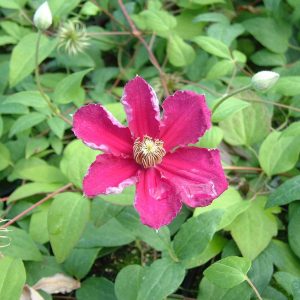Description
Pieris ‘Forest Flame’ is a cultivar of the Pieris species, also known as andromeda or lily-of-the-valley shrub. This cultivar is known for its showy, vibrant red new growth and clusters of drooping, bell-shaped white flowers in spring. It has a compact, mounded growth habit. The leaves are green and glossy and they are lance-shaped, the new growth is a bright red color, adding an extra layer of interest to the plant. It produces clusters of drooping, bell-shaped white flowers in early spring, that are loved by pollinators. After the flowers, small red berries will appear, but it is not guaranteed that they will be produced in every plant. It is adaptable to a range of soil types, prefers acidic soils and partial to full shade, it is also tolerant of cold temperatures and coastal conditions. Pieris ‘Forest Flame’ is suitable for planting in the garden as specimen, as a foundation planting, or as a hedge or screen.
Key Facts
- Common Name(s):Pieris ‘Forest Flame’
- Hardiness:Fully hardy through most of the UK
- How big will I get? Pieris ‘Forest Flame’ can grow to a height of 4m and a spread of 2m.
- Did You Know That:The Japanese Andromeda plant is a member of the Ericaceae family, which also includes rhododendrons and azaleas?
Plant Calendar
A rough guide to how this plant will change through the year.
| Jan | Feb | Mar | Apr | May | June | July | Aug | Sept | Oct | Nov | Dec | |
| Flowering Time |  |
 |
||||||||||
| Foliage Colour |  |
 |
    |
    |
    |
 |
 |
 |
 |
 |
 |
 |
| J | F | M | A | M | J | J | A | S | O | N | D |
 |
 |
||||||||||
 |
 |
    |
    |
    |
 |
 |
 |
 |
 |
 |
 |
Care Guide

Soil Requirements
Pieris ‘Forest Flame’ is a versatile plant and can cope with wet or drier soils, but prefers there to be decent drainage. This plant requires acidic soil to thrive and cannot grow in neutral or alkaline soil conditions.

Best Position
Pieris ‘Forest Flame’ prefers a sheltered position and can cope with either full sun or partial shade.

Maintenance
Pieris ‘Forest Flame’ is fairly low maintenance and doesn’t require any pruning.

Pest, Diseases and Wildlife
Pieris ‘Forest Flame’ can have problems with lacebug, it can be vulnerable to certain diseases such as leaf spot. It is also known to attract bees. It is toxic to cats and dogs.





